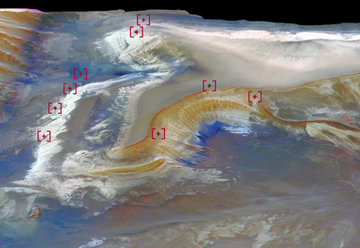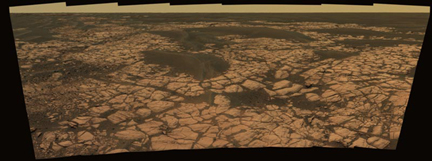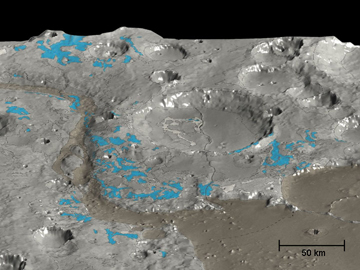Geotimes

Untitled Document

Web Extra
Wednesday, December 7, 2005
Ice in a martian desert
 San
Francisco - The rovers Opportunity and Spirit hit their one-year on Mars
anniversary marks in November and December this year, traveling their respective
patches of the red planet, while the Mars Express orbiter has kicked into high
gear to give broader views some of the planet's icy surfaces. The two missions
have come together in the past few weeks to produce a more complete view of
Mars' water history that has implications for life on the planet, though pieces
of that picture are still contentious.
San
Francisco - The rovers Opportunity and Spirit hit their one-year on Mars
anniversary marks in November and December this year, traveling their respective
patches of the red planet, while the Mars Express orbiter has kicked into high
gear to give broader views some of the planet's icy surfaces. The two missions
have come together in the past few weeks to produce a more complete view of
Mars' water history that has implications for life on the planet, though pieces
of that picture are still contentious.
As
reported at this week's annual meeting of the American Geophysical Union in
San Francisco, the European Space Agency's Mars Express instruments continue
to find more evidence for water ice. The satellite has been orbiting the red
planet for 18 months, using radar and other tools to remotely observe the planet.
So far, the High Resolution Stereo Camera (HRSC) has mapped more than half of
Mars at 50-meter-per-pixel resolution, using a stereo camera that snaps blue-green-red
and infrared imagery.
This
3-D perspective view from a camera aboard the European Space Agency's Mars Express
orbiter, combined with mineral data (in false colors) from the satellite's OMEGA
instrument, shows bright and brown deposits (red markers) that indicate that
substantial quantities of liquid water must have been stably present in the
early history of Mars. Image is courtesy of ESA/OMEGA/HRSC.
 The
satellite looked into a buried crater, described last week in Science Express
on Nov. 30, that seems to be filled to its smooth surface with "cold and
very pure ice," according to Jeffrey Plaut, a research scientist from NASA
Jet Propulsion Laboratory in Pasadena, Calif., who is a co-investigator on the
satellite's Mars Advanced Radar for Subsurface and Ionospheric Sounding. Plaut
said in a press conference on Monday that the deposits in the crater were "nearly
transparent" to the radar instrument, an indication of the presence of
such ice.
The
satellite looked into a buried crater, described last week in Science Express
on Nov. 30, that seems to be filled to its smooth surface with "cold and
very pure ice," according to Jeffrey Plaut, a research scientist from NASA
Jet Propulsion Laboratory in Pasadena, Calif., who is a co-investigator on the
satellite's Mars Advanced Radar for Subsurface and Ionospheric Sounding. Plaut
said in a press conference on Monday that the deposits in the crater were "nearly
transparent" to the radar instrument, an indication of the presence of
such ice.
This view from the panoramic camera
on the Opportunity rover shows an outcrop called Olympia along the northwestern
margin of Erebus crater. The outcrop exposes a broad expanse of sulfate-rich
sedimentary rocks that formed predominantly from windblown sediments, but some
also formed in environmental conditions that were damp or in shallow surface
water. Image courtesy of NASA/JPL-Caltech/Cornell.
 Impacts
and other catastrophic events such as volcanic flows could have melted such
subterranean deposits, releasing water-ice into more obvious river-looking outflow
deposits elsewhere, according to Plaut and other scientists working on data
from Mars Express. The HRSC camera and OMEGA instrument have indicated various
regions where two kinds of rocks that have water are located: sulfates and phyllosilicates
(or clays). The two kinds of rocks indicate a possible shift between two climate
"eras" on Mars, with two very different environments. "Mars 'fell'
dry" around 3.5 billion years ago, said Gerhard Neukum of Free University
in Berlin, principal investigator of HRSC, at the meeting. The early wet era
was dominated by liquid water held in clays, and later, sulfates formed from
evaporation processes in drier climates.
Impacts
and other catastrophic events such as volcanic flows could have melted such
subterranean deposits, releasing water-ice into more obvious river-looking outflow
deposits elsewhere, according to Plaut and other scientists working on data
from Mars Express. The HRSC camera and OMEGA instrument have indicated various
regions where two kinds of rocks that have water are located: sulfates and phyllosilicates
(or clays). The two kinds of rocks indicate a possible shift between two climate
"eras" on Mars, with two very different environments. "Mars 'fell'
dry" around 3.5 billion years ago, said Gerhard Neukum of Free University
in Berlin, principal investigator of HRSC, at the meeting. The early wet era
was dominated by liquid water held in clays, and later, sulfates formed from
evaporation processes in drier climates.
As testament to the planet's wet days from before 3.5 billion years ago, Neukum
presented stunning 3-D imagery of steep cliffsides that had ephemeral waterfalls
running over their edges and swooping river-like landforms and ridges that could
only have been made by volcanic activity and sudden meltwater floods that quickly
evaporated, he said.
In this 3-D perspective view of
the Marwth Vallis area (shades of grey), the OMEGA instrument aboard the Mars
Express orbiter has mapped the water-rich minerals (blue). The instrument has
not detected any hydrated minerals or sediments, either in the channel or in
its opening. However, the outflow was so violent that it eroded and exposed
ancient hydrated clay-rich minerals, suggesting that water was present in an
early era. Image is courtesy of ESA/OMEGA/HRSC.
Jean-Pierre Bibring, principal investigator of OMEGA and researcher at the
Institute of Spatial Astrophysics at the University of Paris-South presented
at the meeting imagery of exposed clays at sites more recently dug up by ephemeral
flows or catastrophic flooding events. Such clay-rich regions potentially could
have harbored life forms — and if they did, they may still hold evidence,
he said.
Meanwhile, on the ground, the Mars rovers have continued to explore new outcrops
in what looks like empty desert, where they've discovered the sulfates from
more recent drier days, evidence of evaporative settings. They've found "an
astonishing, bewildering, delightful diversity of rocks," said Steve Squyres,
principal investigator of the Mars Exploration Rovers mission and professor
at Cornell University in Ithaca, N.Y., at the meeting. Spirit has examined nine
rock types, including familiar wind-blown deposits and in-place bedrock that
has been shattered and crunched by impacts, forming an interesting fractured
pavement. John Grotzinger of Caltech in Pasadena reported halite, or sodium
chloride, in small deposits, probably due to groundwater drying up.
The Mars explorers team also reported that the rovers have had so much excess
solar power that they have managed to stay up for several nights of moongazing
in between daily excursions. A lunar eclipse of Mars' moon Phobos may provide
the opportunity to observe the planet's atmospheric chemistry from spectra taken
from Mars' shadows, the colors of which refract according to the molecules present.
Both rovers have photographed Mars' night sky over several full-night exposures,
snapping Orion's Belt and other stars, as well as capturing possible meteor
streaks left over from the last pass of Halley's Comet. Jim Bell of Cornell
University said that the robots could get about 30 nights of observations —
all without rain, he joked — until their power starts to fade.
The rovers are aging, and the team is treating each day as the last, said John
Callas, deputy project manager for the rovers from the Jet Propulsion Lab. Still,
although Opportunity may lose use of its sampling arm and Spirit's RAT grinding
sampling tool is degrading, the research team remains confident that more work
will continue come from the little explorers.
Grotzinger noted that Mars Express findings are converging with those of the
rovers, particularly when it comes to water on the planet. Still, he and other
rover team members indicated that water remains an unsettled issue. Squyres
said he is reminded of the parable of the blind men examining an elephant: "Mars
is one damn complicated elephant," he said, with evidence both of evaporated
fluids on the plains and of massive channels and valleys elsewhere that show
liquid activity.
Naomi Lubick
Links:
Mars
Exploration Rovers
ESA
Mars Express
For past coverage of dsicoveries and research on
Mars, search the Geotimes site through our Archives.
Untitled Document

Back to top
 San
Francisco - The rovers Opportunity and Spirit hit their one-year on Mars
anniversary marks in November and December this year, traveling their respective
patches of the red planet, while the Mars Express orbiter has kicked into high
gear to give broader views some of the planet's icy surfaces. The two missions
have come together in the past few weeks to produce a more complete view of
Mars' water history that has implications for life on the planet, though pieces
of that picture are still contentious.
San
Francisco - The rovers Opportunity and Spirit hit their one-year on Mars
anniversary marks in November and December this year, traveling their respective
patches of the red planet, while the Mars Express orbiter has kicked into high
gear to give broader views some of the planet's icy surfaces. The two missions
have come together in the past few weeks to produce a more complete view of
Mars' water history that has implications for life on the planet, though pieces
of that picture are still contentious.
 The
satellite looked into a buried crater, described last week in Science Express
on Nov. 30, that seems to be filled to its smooth surface with "cold and
very pure ice," according to Jeffrey Plaut, a research scientist from NASA
Jet Propulsion Laboratory in Pasadena, Calif., who is a co-investigator on the
satellite's Mars Advanced Radar for Subsurface and Ionospheric Sounding. Plaut
said in a press conference on Monday that the deposits in the crater were "nearly
transparent" to the radar instrument, an indication of the presence of
such ice.
The
satellite looked into a buried crater, described last week in Science Express
on Nov. 30, that seems to be filled to its smooth surface with "cold and
very pure ice," according to Jeffrey Plaut, a research scientist from NASA
Jet Propulsion Laboratory in Pasadena, Calif., who is a co-investigator on the
satellite's Mars Advanced Radar for Subsurface and Ionospheric Sounding. Plaut
said in a press conference on Monday that the deposits in the crater were "nearly
transparent" to the radar instrument, an indication of the presence of
such ice.  Impacts
and other catastrophic events such as volcanic flows could have melted such
subterranean deposits, releasing water-ice into more obvious river-looking outflow
deposits elsewhere, according to Plaut and other scientists working on data
from Mars Express. The HRSC camera and OMEGA instrument have indicated various
regions where two kinds of rocks that have water are located: sulfates and phyllosilicates
(or clays). The two kinds of rocks indicate a possible shift between two climate
"eras" on Mars, with two very different environments. "Mars 'fell'
dry" around 3.5 billion years ago, said Gerhard Neukum of Free University
in Berlin, principal investigator of HRSC, at the meeting. The early wet era
was dominated by liquid water held in clays, and later, sulfates formed from
evaporation processes in drier climates.
Impacts
and other catastrophic events such as volcanic flows could have melted such
subterranean deposits, releasing water-ice into more obvious river-looking outflow
deposits elsewhere, according to Plaut and other scientists working on data
from Mars Express. The HRSC camera and OMEGA instrument have indicated various
regions where two kinds of rocks that have water are located: sulfates and phyllosilicates
(or clays). The two kinds of rocks indicate a possible shift between two climate
"eras" on Mars, with two very different environments. "Mars 'fell'
dry" around 3.5 billion years ago, said Gerhard Neukum of Free University
in Berlin, principal investigator of HRSC, at the meeting. The early wet era
was dominated by liquid water held in clays, and later, sulfates formed from
evaporation processes in drier climates. 